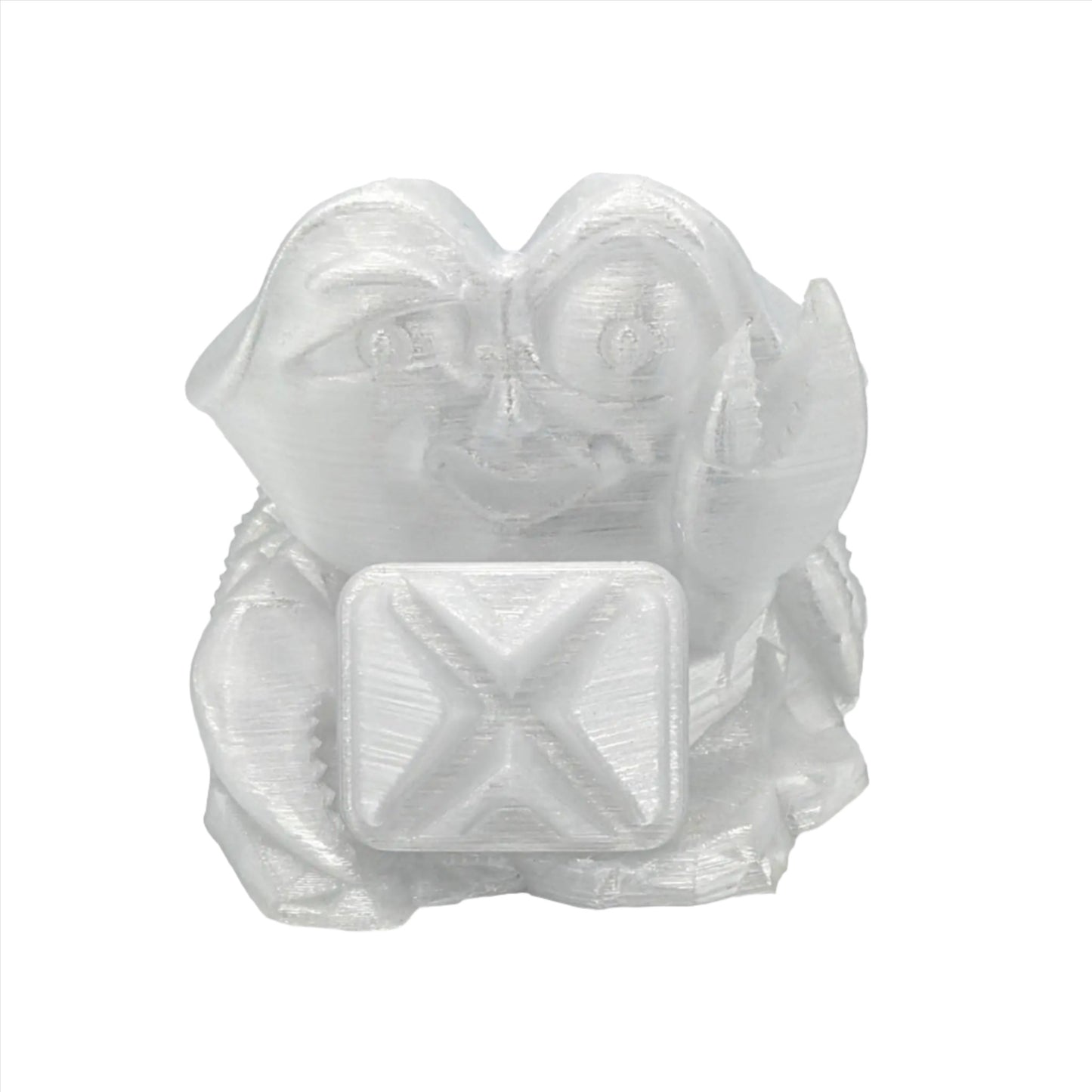


Natural PETG
PETG (PolyEthylene Terephthalate plus Glycol) is a co-polyester used in 3D printing for its durability, impact resistance, and temperature resistance. PETG is the second most popular 3D printing filament behind the ubiquitous PLA. It has qualities comparable to ABS but can be printed without an enclosure or fume handling requirements. Unlike ABS, however, PETG cannot be vapor smoothed using acetone.
Coex 3D Natural PETG is made with Virgin resin and no fillers. All of Coex's filament is made in our production facility located in Wisconsin, USA. Coex 3D uses industrial-grade extruders and laser measuring quality control to ensure quality, consistency, and a 1.75±0.03mm diameter specification with every spool. We provide filament that gives excellent-looking and strong prints.
NOTE: Coex 3D Natural PETG filament appears "clear" and is not a creamy white color as depicted in the "natural" spool photo.
Recommended Print Settings
Coex 3D recommends the following settings when printing with our PETG. Settings will vary depending on your specific print setup.
- Hotend Temperature: 230 °C - 245 °C
- Bed Temperature: 70 °C - 90 °C
- Heated Bed Recommended
- Recommended Build Surfaces/Adhesives:
- PEI Build Surface
- Glass Build Surface
- Magigoo
- Glue Stick
- Painter's Tape
- Cooling Fan: Recommended. PETG works best with slightly less cooling than PLA. 50-75% fan speed is recommended.
- IMPORTANT NOTE! PETG can fuse to glass and PEI print surfaces, causing damage to the print bed when the part is removed. For that reason, Coex 3D recommends always using an additional adhesion agent (such as glue stick or Magigoo) which will help the finished part to release from the print bed.
Other Printing Tips
- PETG is slightly more hygroscopic than PLA, so drying your filament can be necessary if it is exposed to humidity. Coex 3D recommends drying our PETG at 65 °C for at least 3 hours. You can tell when your filament needs drying if you experience under-extrusion/inconsistent extrusion, and/or excess stringing. Hearing a "popping" sound during a print is another sign of filament that needs to be dried.
- PETG can often result in more stringing than would be expected with PLA or similar filaments. There are a few steps you can take to reduce stringing:
- Reduce print temperature. Keep in mind that reducing print temperature will slightly decrease layer adhesion and part strength, but can help reduce stringing.
- Increase retraction. Increasing retraction length can help reduce stringing, especially on Bowden-style extrusion configurations.
- Enable "Wipe while Retracting" in your slicer. Most slicers allow for this option, which will start a travel move just before/during the filament retraction. This helps "wipe off" the nozzle as a travel move starts, reducing stringing.
- Enable "Combing Mode" (Cura) or "Avoid Crossing Perimeters" (PrusaSlicer/SuperSlicer/etc.). Rather than travel moves always going in a straight line, this will cause them to choose a path that avoids crossing over perimeters, effectively keeping the nozzle "inside" the print area wherever possible. This eliminates stringing right at the source but still cannot eliminate it all (such as between multiple parts).
- Unfortunately in many cases stringing is impossible to fully eliminate, so some post-processing of prints is often necessary.
Technical Printing Guide - COEX PETG
1. Material Notes
- Keep filament dry - store properly and dry before use
- If needed, dry at 65°C for 3 hours or more
- Enclosure is helpful but not mandatory
- Use Z-offset slightly higher than PLA (+0.05mm)
- Enable "Avoid crossing perimeters" to reduce stringing
- Consider using the "Wipe while retract" option
- Enable "Slow down for small perimeters."
- Print outer walls slower for better quality
- Use a minimum layer time of 30 seconds for small parts
- Enable cooling gradually after the first layer
- Consider using "Extra Prime Amount" after retraction
2. Basic Parameters
| Nozzle | Layer Height | Line Width | Volumetric Speed | Temperature |
| 0.4mm | 0.2mm | 0.42mm | 14.0 mm³/s | 235°C |
| 0.6mm | 0.3mm | 0.62mm | 31.5 mm³/s | 235°C |
| 0.8mm | 0.4mm | 0.82mm | 56.0 mm³/s | 240°C |
| 1.0mm | 0.5mm | 1.02mm | 87.5 mm³/s | 245°C |
3. Speed Settings
0.4mm Nozzle (Volumetric Speed: 14.0 mm³/s)
| Line Type | Percentage | Speed |
| External Perimeter | 50% | 83.33 mm/s |
| Internal Perimeters | 75% | 125.00 mm/s |
| Infill | 100% | 166.67 mm/s |
| Top/Bottom | 60% | 100.00 mm/s |
| First Layer | 30% | 50.00 mm/s |
0.6mm Nozzle (Volumetric Speed: 31.5 mm³/s)
| Line Type | Percentage | Speed |
| External Perimeter | 50% | 84.68 mm/s |
| Internal Perimeters | 75% | 127.02 mm/s |
| Infill | 100% | 169.35 mm/s |
| Top/Bottom | 60% | 101.61 mm/s |
| First Layer | 30% | 50.81 mm/s |
0.8mm Nozzle (Volumetric Speed: 56.0 mm³/s)
| Line Type | Percentage | Speed |
| External Perimeter | 50% | 85.37 mm/s |
| Internal Perimeters | 75% | 128.05 mm/s |
| Infill | 100% | 170.73 mm/s |
| Top/Bottom | 60% | 102.44 mm/s |
| First Layer | 30% | 51.22 mm/s |
1.0mm Nozzle (Volumetric Speed: 87.5 mm³/s)
| Line Type | Percentage | Speed |
| External Perimeter | 50% | 85.78 mm/s |
| Internal Perimeters | 75% | 128.68 mm/s |
| Infill | 100% | 171.57 mm/s |
| Top/Bottom | 60% | 102.94 mm/s |
| First Layer | 30% | 51.47 mm/s |
4. Retraction Settings
IMPORTANT: Set travel speed to the maximum your machine allows (200-500mm/s). Faster movements reduce filament oozing time, minimizing stringing.
| Nozzle | Distance | Speed | Z-Hop |
| 0.4mm | 1.0-1.5mm | 40mm/s | 0.2mm |
| 0.6mm | 1.0-1.5mm | 40mm/s | 0.2mm |
| 0.8mm | 1.0-1.5mm | 40mm/s | 0.2mm |
| 1.0mm | 1.0-1.5mm | 40mm/s | 0.2mm |
5. Temperature Settings
Bed Temperature: 70-90°C
- Wash the bed often for good adhesion - Use dish soap and rinse thoroughly to remove oils
- Use bed adhesion products if necessary (gluestick, WELD3D)
- Use brim for tall or large prints
- Keep the ambient temperature stable
Extruder Temperature: 230-245°C
6. Cooling Settings
Cooling Configuration:
Fan Speed Settings:
- First Layer: 0% (fan off)
- General Printing: 40% fan speed
- Bridges and Overhangs: 70% fan speed
- Layers < 30 seconds: 70% fan speed
Advanced Settings:
- Keep Fan Always On: YES
- Force Fan Speed for Overhangs: YES
- Minimum Layer Time: 30 seconds
- Force Fan Speed for Small Perimeters: YES
Additional Cooling Notes:
- Enable gradual fan speed increase after the first layer
- Increase fan speed for small, detailed parts
- Consider reducing fan speed for better layer adhesion if needed
- Monitor overhangs and bridge quality to adjust fan speed
7. Troubleshooting Guide
| Problem | Solution |
| Irregular extrusion |
1. Dry the filament 2. Check the extruder 3. Reduce speed |
| Poor adhesion |
1. Dry the filament 2. Use adhesive 3. Adjust the first layer |
| Stringing |
1. Dry the filament 2. Adjust retraction 3. Increase travel speed 4. Check temperature |
PLEASE NOTE: These printing parameters are initial recommendations based on our experience. They may need adjustment depending on your specific 3D printer, environmental conditions, and the geometry of the part you are printing. Use these settings as a starting point and fine-tune them according to your specific needs.



